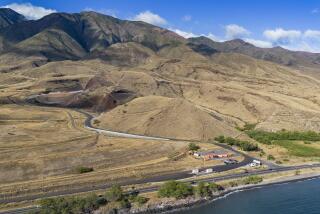Developers, Native Hawaiians Square Off on Cultural Issues : Battle Over Ancient Burial Site Halts New Maui Hotel
HONOLULU — Protesters angry that ancient human remains were dug up to make way for a luxury hotel have halted a Maui island resort’s construction and given new life to the fight between developers hoping to lure more tourists here and Hawaiian activists trying to preserve the islands’ culture.
“Although this land was once ruled by Hawaiians, they are no longer part of the power elite. I don’t think this could happen to the grave site of a more powerful group,” said Hawaiian activist Edward Kanahele, a spokesman for the group Malama Na Kapuna, or Caring for Our Ancestors. “It’s been painful for us to see so many other burial sites paved over or dug up, but we were never organized enough before. Now we are.”
It was hundreds of protesters like Kanahele, with the sympathy of part-Hawaiian Gov. John Waihee, who forced a temporary halt Dec. 23 to the excavation of the second-largest known Hawaiian burial site in this island chain.
900 Skeletons Exhumed
By then, more than 900 skeletons had been exhumed, most believed to have been buried more than 1,000 years ago.
But the state cannot force Kapa-lua Land Co. Inc. to give up its plan to build the nearly $100-million, 450-room Ritz Carlton hotel on Maui’s northwest shore.
Kapalua has the county-issued construction permits it needs, and halted the excavation only as long as it takes to work out a compromise.
Kanahele said it was up to Hawaii residents concerned with its history and culture to stop the “desecration of burial sites and removal of our culture.”
As recently as 20 years ago, when bones were regularly found at construction sites, they were often burned, thrown away or just left at the site. That treatment was considered desecration; according to ancient Hawaiian tradition, a person’s “mana,” or spirit, lived on with his remains.
“We mainly have to look at the morality and religious aspects of this issue,” Kanahele said. “Those bones have been buried there for thousands of years, they are our history and our culture. We should not be swayed by the brief economic interlude provided by a hotel that surely won’t last as long as those remains.”
Says Firm Knew of Site
Kapalua Land is a subsidiary of Maui Land & Pineapple Co., and the latter’s chairman, Colin Cameron, said the presence of the burial ground was known before the site was chosen. He said he worked closely with Maui County and the Office of Hawaiian Affairs, a state agency that represents native Hawaiian interests, before the construction permits were granted.
“OHA knew all along that it was a large and possibly very significant site and they agreed to the excavation,” said Paul Rosendahl, an archeologist hired to excavate the grounds. He reported weekly to OHA and a Maui Hawaiian group after the dig began.
But Linda Delaney, the OHA’s land and natural resources officer, said the site’s significance has only recently become clear. “The history of the site wasn’t well documented and people just didn’t realize how many people were buried there,” she said. “Now that we know, we’re trying to stop it.”
Earlier this month, OHA passed a resolution calling for a permanent halt to the excavation, reburial of the remains, consultation with local Hawaiian activist groups and the designation of the 2.3-acre burial site as “culturally sensitive” and off-limits to development.
Appeal to Conscience
When asked where that leaves the development company, which has already poured $3 million into the project, Delaney said: “I don’t know what happens to the hotel. Those are the kinds of questions that need to be worked out . . . . We have to appeal to the community conscience, the developer’s conscience.”
Kapalua Land agreed to rebury the bones about a mile from the hotel site. With the excavation 85% complete, it is too late to preserve the original burial site, Cameron said.
He said he was surprised by opposition to the dig. Excavation began in August of 1987, and there were no protests at the site until last December.
Meanwhile, the remains are being stored at the Kapalua site, said Rosendahl, who would like to analyze the skeletons. “It’s such a complete population,” he said. “We could learn so much about the ancient Hawaiian culture from this dig.”
But Kanahele said the activists do not want the bones dusted off.
“Their afterlife has already been affected,” he said. “They’ve gone through enough.”
More to Read
Sign up for Essential California
The most important California stories and recommendations in your inbox every morning.
You may occasionally receive promotional content from the Los Angeles Times.










